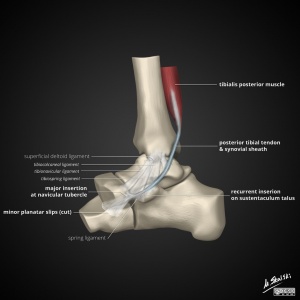Tibialis Posterior: Difference between revisions
Michelle Lee (talk | contribs) No edit summary |
Michelle Lee (talk | contribs) No edit summary |
||
| Line 1: | Line 1: | ||
= Anatomy and Function = | = Anatomy and Function = | ||
{| width="800" border="1" cellpadding="1" cellspacing="1" | {| width="800" border="1" cellpadding="1" cellspacing="1" | ||
| Line 25: | Line 25: | ||
|- | |- | ||
| Function | | Function | ||
| To plantarflex and invert the ankle. It also plays an important role in stabilising the medial longitudinal arch. | | To plantarflex and invert the ankle. It also plays an important role in stabilising the medial longitudinal arch. | ||
|} | |} | ||
| Line 34: | Line 34: | ||
[[Image:Tibialis-posterior-location.jpg|thumb|left|300x300px]]<br> | [[Image:Tibialis-posterior-location.jpg|thumb|left|300x300px]]<br> | ||
== References == | == References == | ||
<references /> | <references /> | ||
Revision as of 17:27, 30 September 2015
Anatomy and Function[edit | edit source]
| Origion |
Proximal posterolateral aspect of the tibia. Proxmial posteromedial aspect of the fibula and the interosseous membrane. |
| Mid portion |
Situated in the deep posterior compartment of the lower leg and runs proximal to the medial malleoli where it is secured by the flexor retinaculum. |
| Insertion |
The major insertion is onto the navicula and the plantar slip attatches to the medial cuniform |
| Innervation |
Tibial Nerve (L4-S3) |
| Function | To plantarflex and invert the ankle. It also plays an important role in stabilising the medial longitudinal arch. |
References[edit | edit source]
- ↑ Drake RL, Vogl W, Mitchell AWM. Gray's Anatomy for Students. 2nd Ed. Philadelphia: Churchill Livingstone Elsevier, 2010.








